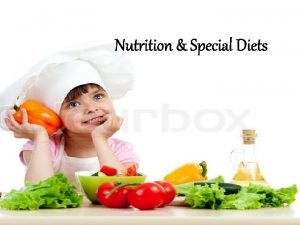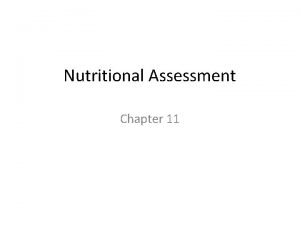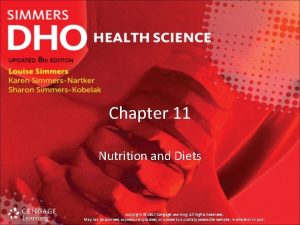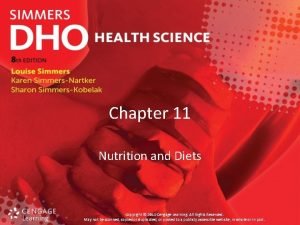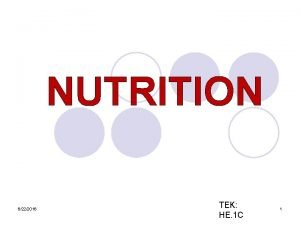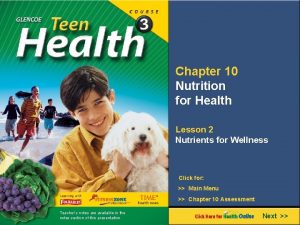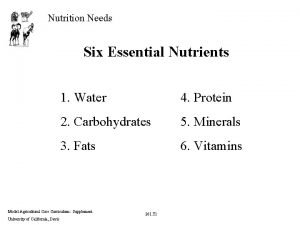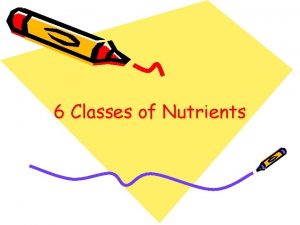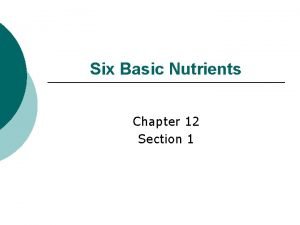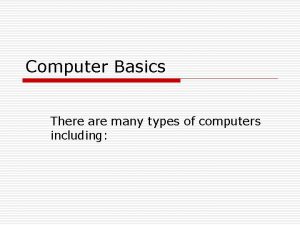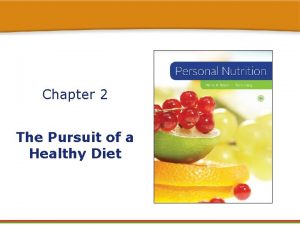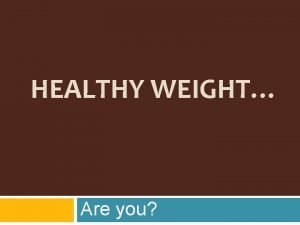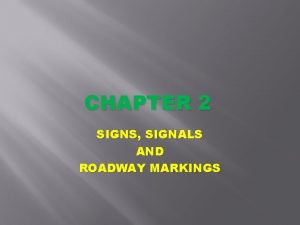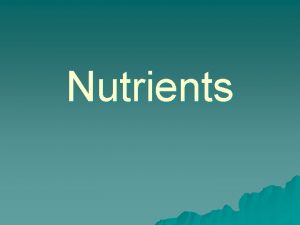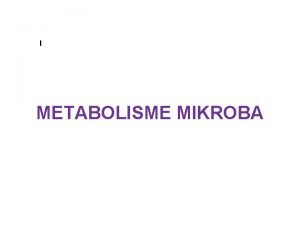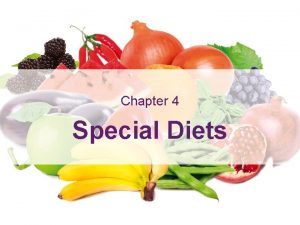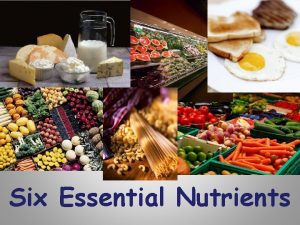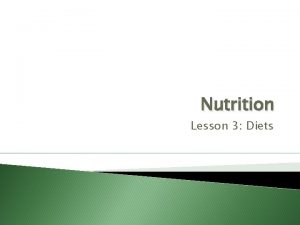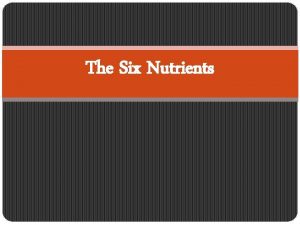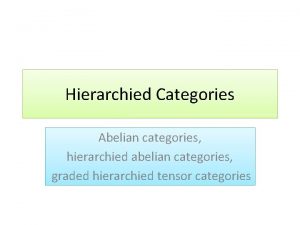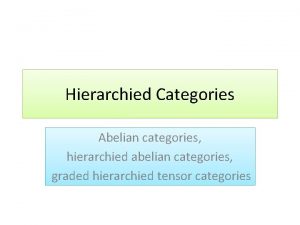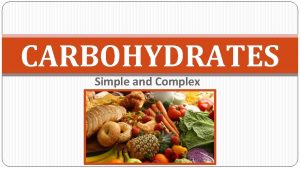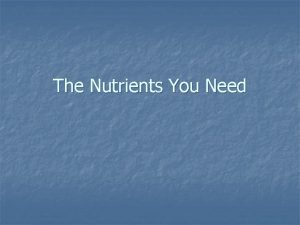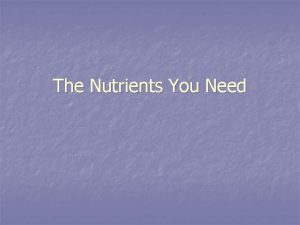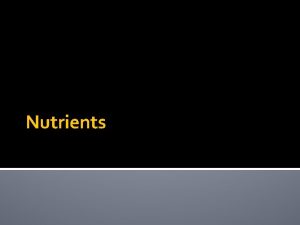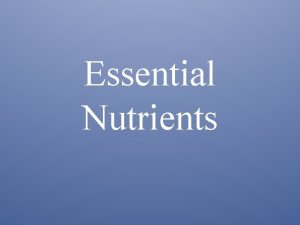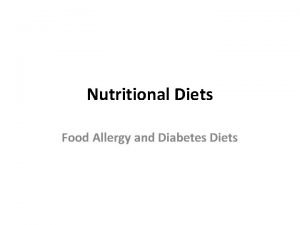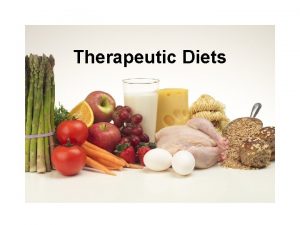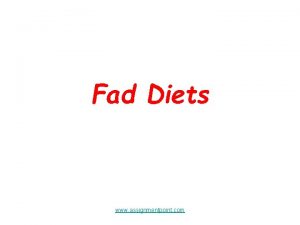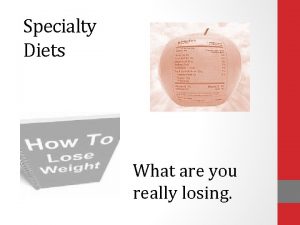Nutrition Special Diets What are nutrients Six categories

























- Slides: 25

Nutrition & Special Diets

What are nutrients? Six categories of nutrients

Carbohydrates Simple Carbohydrates Foods with LOTS of sugar: oranges, milk, cookies, candy

Complex Carbohydrates Starches that are composed of many sugars _________________ They provide the body ____________________since they are digested more slowly than sugars. Foods with LOTS of starch:

Protein Structure: Proteins are made from many ______________ connected together in different arrangements. Function: Provide the ________________your body needs to grow and repair itself Complete proteins: Foods containing: Examples: fish, meat, eggs, milk, cheese

Incomplete proteins Examples: Legumes, nuts, whole grains Fat Functions: _____________ source for the body (more than _______ and ________) Help protect and cushion vital organs as well as joints

Fat Structure: Fats belong to a group of organic compounds called lipids which are substances that ____________________________. Fatty acids are the ______________of fats. Unsaturated fats: Contain fatty acids that are missing hydrogen atoms At room temperature, they are typically in _________ form. Foods with a lot of unsaturated fat:

Saturated fats: Contain fatty acids with the MAXIMUM amount of hydrogen atoms At room temperature, they are typically _________________________. Diets with ________________saturated fat have been known to cause ______________ Foods with a lot of saturated fat:

Calories What is a calorie? The __________obtained from carbohydrates, proteins, and fats is __________in units called calories.

Do you know the MOST IMPORTANT nutrient is? Function Assists with the transport of materials in the body by making up most of the __________of blood (plasma) Helps regulate body temperature, and helps break down food in the ______________ Food sources: vegetables, fruit, milk

Micronutrients Minerals and vitamins are called micronutrients since they are needed by your body in ___________ amounts. The minerals and most of the vitamins your body needs must be obtained from the FOODS you eat since your body cannot _____________. Micronutrients: Minerals are ____________substances that are required by your body in order to develop and grow properly. Some Important Minerals:

Calcium Function: Helps build strong bones and teeth, regulates _____________clotting Food sources: dairy products, leafy and green vegetables Iron Function: Helps build hemoglobin which is the _________________of your red blood cells Food sources: eggs, meats, whole grains

Potassium Function: Helps regulate ______________in the body, assists with the normal functioning of muscles and nerves Food sources: Micronutrients: Vitamins: Group of __________________that help your body maintain normal metabolism, growth, and development Two Groups of Vitamins:

Water-Soluble Vitamins: Vitamins that dissolve in water and are NOT _____________________________ Vitamin _____ and Vitamin _____ Fat-Soluble Vitamins: Vitamins that dissolve into and are transported by fat They can be stored in: Vitamins A, D, E, and K

Fruits Group 1. Use fruits as snacks, salads or desserts. 2. Choose whole or cut up fruits more often than fruit juice. Key Consumer Message: Boys 9 -13 1 ½ c. daily Boys 14 -18 2 c. daily Girls 9 -18 1 ½ c. daily

Vegetables Group 1. Choose fresh, frozen, canned or dried. 2. Eat red, orange and dark green vegetables. Key Consumer Message: Boys 9 -13 2 ½ c. daily Boys 14 -18 3 c. daily Girls 9 -13 2 c. daily Girls 14 -18 2 ½ c. daily

Protein Group 1. Choose a variety of different protein sources. 2. In place of some meat and poultry, choose 8 oz. seafood per week. 3. Try grilling, broiling, poaching or roasting. Boys 9 -13 5 oz. daily Key Consumer Message: Boys 14 -18 6 ½ oz. daily Girls 9 -18 5 oz. daily

Grains Group 1. Choose 100% whole grain cereals, breads, crackers, rice and pasta. 2. Check the ingredients list on food packages to find whole grain foods. Key Consumer Message: Grains Whole Grains Boys 9 -13 6 oz. daily 3 oz. daily Boys 14 -18 8 oz. daily 4 oz. daily Girls 9 -13 5 oz. daily 2. 5 oz. daily Girls 14 -18 6 oz. daily 3 oz. daily

Dairy Group 1. Low-fat or fat-free dairy products have the same amount of calcium and other essential nutrients as whole milk, but less fat and calories. Key Consumer Message: Boys 9 -18 3 c. daily Girls 9 -18 3 c. daily

Portion control is: Understanding how much a _________ ______is and how many calories a serving contains. It is important for weight management as the weight is defined by the total ___________intake

Special

Vegan • _________: a person who does not eat or use any animal products • ____________: excludes all food and products of animal origin, as well as food cooked at a temperature above 118 °F

Vegetarians -Pescatarian: one whose diet includes ___________but no other meat – Ovo: diet allows for the consumption of _________; no dairy products or animal flesh are allowed. – Lacto: diet includes _______products such as milk, cheese, butter, cream, but excludes eggs and meat – Ovo-lacto: diet does not include animal flesh of any kind, but _________ dairy and egg products.

Gluten Intolerance • ____________ Intolerant (Celiac): Intolerance to products containing gluten – an autoimmune disorder of the small intestines that occurs in genetically predisposed people of all ages from middle infancy onward. • Gluten is a protein composite found in ________ • Gluten-free food is normally seen as a diet for celiac disease, but having a gluten allergy also has similar diet needs • Grains that can be eaten: corn, potatoes, rice, tapioca, quinoa, beans, soybean, nut flours

Other Special Diets • Low Fat, Calorie, Cholesterol, Sodium, Sugar Diets • __________ Diets • ___________Diets (Fad Diets): involve making extreme, rapid changes to food consumption • ____________ Diet: involve either not consuming or attempting to flush out substances that are considered unhelpful or harmful
 Six categories of nutrients
Six categories of nutrients Antigentest åre
Antigentest åre Chapter 11 nutrition and diets
Chapter 11 nutrition and diets Define optimal nutritional status
Define optimal nutritional status Chapter 11 nutrition and diets
Chapter 11 nutrition and diets Chapter 11 nutrition and diets key terms
Chapter 11 nutrition and diets key terms 6 essential nutrients
6 essential nutrients Seven nutrients
Seven nutrients Chapter 10 nutrition for health lesson 2 nutrients
Chapter 10 nutrition for health lesson 2 nutrients Six essential nutrients
Six essential nutrients Six classes of nutrients
Six classes of nutrients Six basic nutrients
Six basic nutrients Six major categories of hardware
Six major categories of hardware Categories of technology
Categories of technology Six basic categories of computers
Six basic categories of computers Braking system components
Braking system components Diets based on only one basic food element
Diets based on only one basic food element Most fad diets do follow the mypyramid guidelines.
Most fad diets do follow the mypyramid guidelines. Fad diets def
Fad diets def Classify each polygon
Classify each polygon Six pillars of special education
Six pillars of special education What are six types of special roadway markings
What are six types of special roadway markings What are six types of special roadway markings?
What are six types of special roadway markings? Six trigonometric functions of special angles
Six trigonometric functions of special angles Substances that nourish the body
Substances that nourish the body Peta konsep materi lemak
Peta konsep materi lemak
